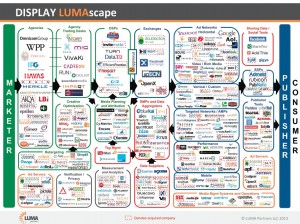Ie, what types of information are contained within the cookies made available? Thanks!
This question was asked on Quora.com, below is my answer.
 In a typical RTB transaction there’s a user ID, pulled from the user’s cookie or some form of server side system, which is passed to the DSP from the SSP. That ID is, in most cases, the DSPs record locator for the user’s information. Most DSPs have a server side data store where this information is housed, updated and augmented from a variety of sources including data companies like Blue Kai and Excelate and their ilk. DSPs may also be collecting and distilling information based on bid request activity from that user (although most SSPs put language into the contracts governing the use of this “bid stream” data) or retargeting data gathered for their customers. This type of data system is generally referred to as a Data Management Platform (DMP) in the industry. While there are some stand-alone DMPs out there, more and more DSPs are integrating or building their own.
In a typical RTB transaction there’s a user ID, pulled from the user’s cookie or some form of server side system, which is passed to the DSP from the SSP. That ID is, in most cases, the DSPs record locator for the user’s information. Most DSPs have a server side data store where this information is housed, updated and augmented from a variety of sources including data companies like Blue Kai and Excelate and their ilk. DSPs may also be collecting and distilling information based on bid request activity from that user (although most SSPs put language into the contracts governing the use of this “bid stream” data) or retargeting data gathered for their customers. This type of data system is generally referred to as a Data Management Platform (DMP) in the industry. While there are some stand-alone DMPs out there, more and more DSPs are integrating or building their own.
There are a variety of other bits of information about the ad impression that get passed in the bid stream. To get a sense of what might be passed you can look at the Open RTB API (http://code.google.com/p




 Bernhard Glock of Medialink, who was not on the panel, but chimed in with a profound thought. Buying on television is buying something that’s familiar, with seemingly known or at least comfortable impact and expectations on results. By contrast, buying online display is a complete mystery. His solution, just buy on television because that’s what he understands.
Bernhard Glock of Medialink, who was not on the panel, but chimed in with a profound thought. Buying on television is buying something that’s familiar, with seemingly known or at least comfortable impact and expectations on results. By contrast, buying online display is a complete mystery. His solution, just buy on television because that’s what he understands.

